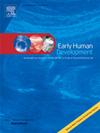Perinatal asphyxia with no or mild hypoxic-ischaemic encephalopathy: Two-year neurodevelopmental outcome
IF 2
3区 医学
Q2 OBSTETRICS & GYNECOLOGY
引用次数: 0
Abstract
Objective
To characterize 2-year neurodevelopment of infants with perinatal asphyxia without hypoxic-ischemic encephalopathy (HIE) or with mild HIE (HIE1) and analyse possible correlations with sex, brain MRI findings or early neurological examination.
Methods
Term infants with perinatal asphyxia and a control group were prospectively recruited from the neonatal units of Helsinki University Hospital in 2016–2020. The study cohort included infants with no or minor neurological symptoms during first 6 h after birth. Neurodevelopment was assessed using Hammersmith Infant Neurological Examination (HINE) at three months and at two years, Griffiths Scales of Child Development, 3rd edition (GMDS-III) and Bayley Scales of Infant and Toddler Development, 3rd Edition (BSID-III) at two years.
Results
Study included 89 infants: 32 study cohort infants and 57 healthy controls. In the study cohort 1/32 and in the control group 0/57 of the infants showed significantly below normative mean cognitive score in BSID-III. Respective frequency of significantly below normative mean receptive language score were 2/32 and 0/57 and expressive language score 4/32 and 8/57. Females with perinatal asphyxia performed better in the language scores of GMDS-III and BSID-III. Children with asphyxia-related findings in brain MRI had statistically significantly lower total score, language and communication and foundations of learning subscore of GMDS-III.
Conclusions
Most infants with perinatal asphyxia without HIE or with HIE1 performed typically at two years. However, infants with asphyxia-related MRI findings showed lower cognitive and language scores. Our results suggest that female sex may be associated with a lower risk of any subtle effects.
围产期窒息伴无或轻度缺氧缺血性脑病:两年神经发育结局
目的探讨围产期窒息无缺氧缺血性脑病(HIE)或轻度HIE (HIE1)患儿2年神经发育特征,并分析其与性别、脑MRI表现或早期神经学检查的可能相关性。方法2016-2020年在赫尔辛基大学医院新生儿病房前瞻性招募围产期窒息新生儿和对照组。研究队列包括出生后6小时内没有或只有轻微神经症状的婴儿。在3个月和2岁时分别使用Hammersmith婴儿神经系统检查(HINE)、Griffiths儿童发育量表第3版(GMDS-III)和Bayley婴幼儿发育量表第3版(BSID-III)评估神经发育。结果研究纳入89例婴儿:32例研究队列婴儿和57例健康对照。在研究队列中1/32和对照组中0/57的婴儿在BSID-III中表现出显著低于标准平均认知评分。显著低于规范平均接受性语言得分的频率分别为2/32和0/57,显著低于表达性语言得分的频率分别为4/32和8/57。围生期窒息的女性在GMDS-III和BSID-III语言评分上表现较好。脑MRI中出现窒息相关症状的患儿GMDS-III总分、语言沟通和学习基础评分均有统计学意义。结论围生期窒息无HIE或HIE1型患儿多在2岁时发病。然而,与窒息相关的MRI结果显示,婴儿的认知和语言评分较低。我们的研究结果表明,女性可能与任何微妙影响的风险较低有关。
本文章由计算机程序翻译,如有差异,请以英文原文为准。
求助全文
约1分钟内获得全文
求助全文
来源期刊

Early human development
医学-妇产科学
CiteScore
4.40
自引率
4.00%
发文量
100
审稿时长
46 days
期刊介绍:
Established as an authoritative, highly cited voice on early human development, Early Human Development provides a unique opportunity for researchers and clinicians to bridge the communication gap between disciplines. Creating a forum for the productive exchange of ideas concerning early human growth and development, the journal publishes original research and clinical papers with particular emphasis on the continuum between fetal life and the perinatal period; aspects of postnatal growth influenced by early events; and the safeguarding of the quality of human survival.
The first comprehensive and interdisciplinary journal in this area of growing importance, Early Human Development offers pertinent contributions to the following subject areas:
Fetology; perinatology; pediatrics; growth and development; obstetrics; reproduction and fertility; epidemiology; behavioural sciences; nutrition and metabolism; teratology; neurology; brain biology; developmental psychology and screening.
 求助内容:
求助内容: 应助结果提醒方式:
应助结果提醒方式:


